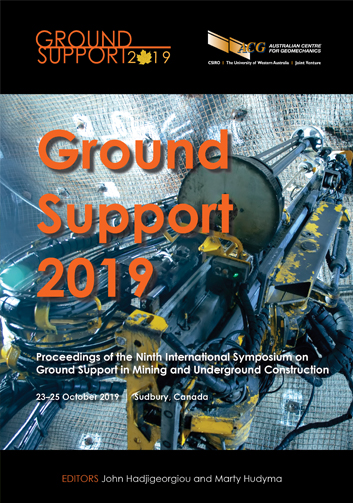Advanced geotechnical monitoring technology to assess ground support effectiveness

|
Authors: Gelinas, LP; Falmagne, V; Bedard, B; Matte, O |
DOI https://doi.org/10.36487/ACG_rep/1925_02_Gelinas
Cite As:
Gelinas, LP, Falmagne, V, Bedard, B & Matte, O 2019, 'Advanced geotechnical monitoring technology to assess ground support effectiveness', in J Hadjigeorgiou & M Hudyma (eds), Ground Support 2019: Proceedings of the Ninth International Symposium on Ground Support in Mining and Underground Construction, Australian Centre for Geomechanics, Perth, pp. 59-74, https://doi.org/10.36487/ACG_rep/1925_02_Gelinas
Abstract:
Deformation at the surface of excavations in hard rock often occurs on a millimetre scale, which means the movements cannot be readily detected through visual inspection. These slight rates of deformation can lead to cracking, bulking, wedges and even loss of material that may go unnoticed or be deemed unimportant until significant rehabilitation is needed. The impact of such deformation on ground support capacity over time is difficult to assess quantitatively. Other than visual inspections, traditional excavation monitoring technologies typically entail point measurements, such as with extensometers, prisms or convergence measurement systems. The scanning and surveying of specific excavation cross-sections are also used. The authors of this paper have tested a new technology for underground monitoring. GroundProbe’s Geotech Monitoring LiDAR (GML) system has millimetre-range accuracy and measures the rate of deformation at the rock surface with high precision in each pixel of a 360° image. The system can measure the rate of deformation of ground support elements and the surrounding rock or shotcrete surface at any given time, in any drive, intersection or stope entry. This technology was tested in two different hard rock underground environments through a process of experimentation and validation. The GML system was used to monitor large critical infrastructure with shotcrete walls and roofs, compare bolt displacements in different geological contexts and stress environments, and monitor the rock mass and ground support response to stope and development blasts. The impact of bolt spacing and bolt type on rock surface deformation was also measured. Testing of the technology to date has demonstrated clear value and has the potential to assist ground control engineers by providing visual records and quantitative assessments of rock mass deformation and ground support performance. Advanced deformation monitoring can be a valuable asset for optimising ground support design and monitoring ground support performance.
Keywords: rock mass deformation, monitoring, ground support, GML, LiDAR
References:
Agnico Eagle Mines Ltd 2018, Internal geology presentation to Goldex GEZ Team, January.
Agnico Eagle Mines Ltd 2007, Pinos Altos Gold Project Feasibility Study, April.
Campbell, L, Cabrejo, AG, Chen, BJ & Saunders, P 2017, ‘A novel geotechnical monitoring technology for underground tunnels to assess ground support effectiveness’, Proceedings of the 16th Australasian Tunnelling Conference 2017: Challenging Underground Space—Bigger, Better, More, Engineers Australia, Barton, pp. 187–197.
Campbell, L, Edwards, D, Noon, D, Bellett, P & Ferdinands, N 2015, ‘A new radar technology approach for monitoring high walls and Low walls’, in JW Beester (ed.), Bowen Basin Symposium 2015: Bowen Basin and Beyond, GSA Coal Geology Group, Hornsby, pp. 329–338.
Counter, D 2017, ‘Strain and rock bursting at Kidd Creek: support response and recent work on damage measurement systems’, paper presented at the Strainburst in Mining Seminar – How to Mitigate the Consequences, Sudbury, 10 October 2017.
Harries, N, Noon, D & Rowley, K 2006, ‘Case studies of slope stability radar used in open cut mines’, Proceedings of the International Symposium on Stability of Rock Slopes in Open Pit Mining and Civil Engineering, The Southern African Institute of Mining and Metallurgy, Johannesburg, pp. 335–342.
Kalenchuk, L, Falmagne, V, Gelover, A, Montiel, I & Luzania J 2019, ‘Risk evaluation, design, implementation, instrumentation, and verification for crown pillar extraction at Pinos Altos mine,’ Rock Mechanics and Rock Engineering,
© Copyright 2025, Australian Centre for Geomechanics (ACG), The University of Western Australia. All rights reserved.
View copyright/legal information
Please direct any queries or error reports to repository-acg@uwa.edu.au
View copyright/legal information
Please direct any queries or error reports to repository-acg@uwa.edu.au